AstroAI Multimeter 2000 Counts Digital
Multimeter with DC AC Voltmeter and
Ohm Volt Amp Tester User Manual
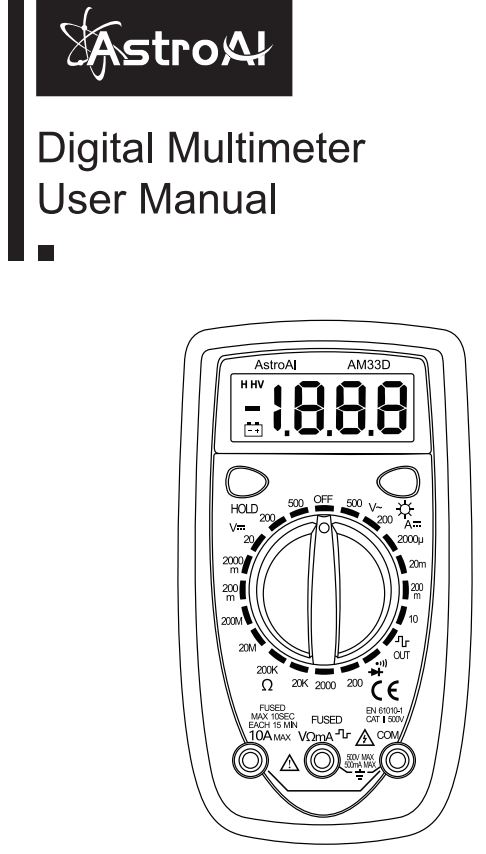
Thank you for purchasing the Digital Multimeter from AstroAI. The AstroAI Digital Multimeter is designed to be safely and accurately used in schools, laboratories, factories and other social/industrial fields. This user manual provides all the safety information, operation instruction, specifications, and maintenance for the meter. This instrument performs AC/DC Voltage, DC Current, Resistance, Diode Testing and Continuity Testing. Thank you again for choosing AstroAI, if you have any questions or concerns regarding your product, please contact us at [email protected].
NOTE:
Fully read and comprehend this manual before using this Digital Multimeter.
WARNING
To avoid possible electric shocks, personal injury and to avoid possible damage to the Meter or to the equipment being tested, adhere to the following rules:
- Use the Meter strictly in accordance with this manual, otherwise the protection function provided by the Meter may be damaged or weakened.
- Please be especially careful when measuring over 60V DC, 30V AC RMS or 42V peak value, there is a danger of electric shocks.
- Do not apply more than the rated voltage marked on the Meter, between the terminals or between any terminal and grounding.
- Check whether the Meter is working normally by measuring the known voltage, do not use it if the readings are incorrect or the Meter is damaged.
- Before using the meter, please check whether there are cracks or damage to the plastic parts of the meter casing. Do not use the Meter if all or part of the exterior casing is damaged.
- Before using the Meter, please check whether the test leads are cracked or damaged. Please replace the test leads with those oft he same model and same electrical specifications if the leads are damaged.
- Use the Meter according to the measurement category, voltage or current rating specified on the meter or manual.
- Comply with local and national safety regulations. Wear personal protective equipment (such as approved rubber gloves, masks, and flame-retardant clothing, etc.) to prevent injury from electric shocks and arcs when hazardous live conductors are exposed.
- Replace the battery as soon as the low-battery indicator appears to avoid measurement errors.
- Do not use the Meter around explosive gas, steam or humid environ mints.
- When using the test leads, keep your fingers behind the finger guards.
- When measuring, connect the neutral wire or ground wire first, then connect the live wire; when disconnecting, disconnect the live wire first, and then disconnect the neutral and ground wires.
- Before opening the case or battery cover, remove the test leads from the Meter first. Do not use the Meter when it is disassembled or when the battery cover is opened.
- The Meter can only be used with the equipped test leads to meet the requirements of safety standards. If the test leads are damaged and need to be replaced, replace only with the same model and the same electrical specifications.
ELECTRICAL SYMBOLS

SIZE
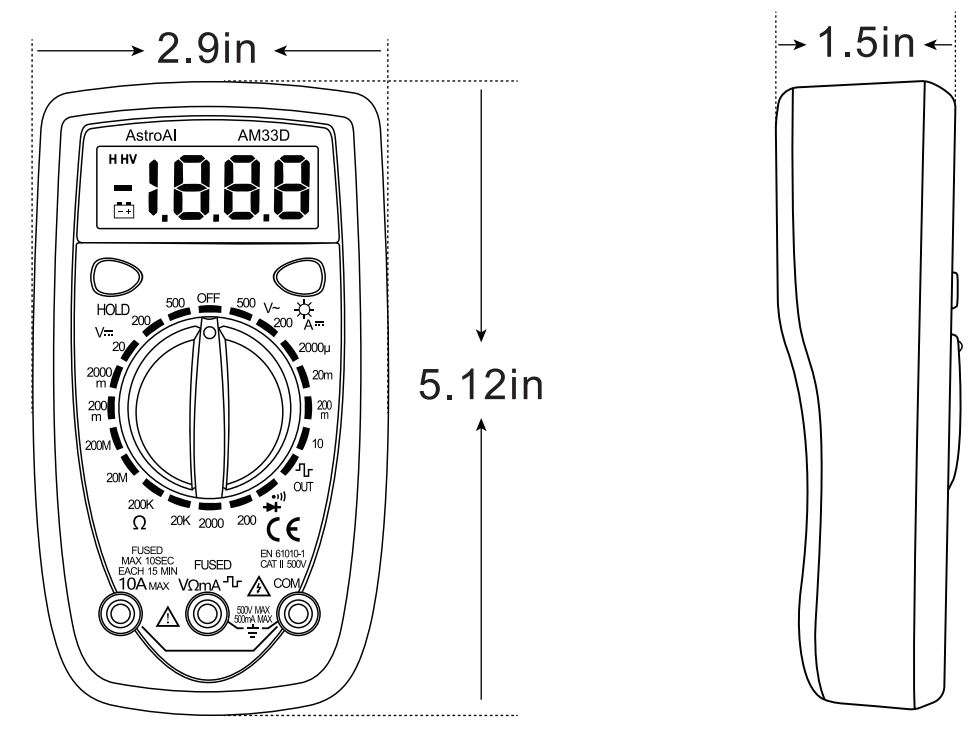
DIAGRAM

- CD LCD Screen
- Hold Button
- Backlight Button
- Rotary Switch
- OFF
- DC Voltage Test
- Resistance
- AC Voltage Test
- DC Current Test
- Square Wave Output
- Continuity Test/Diode Test
- 10A Termina
- VΩmA-‘lr Terminal
- Com Terminal
- Test Leads
GETTING TO KNOW YOUR DEVICE
BUTTON FUNCTIONS


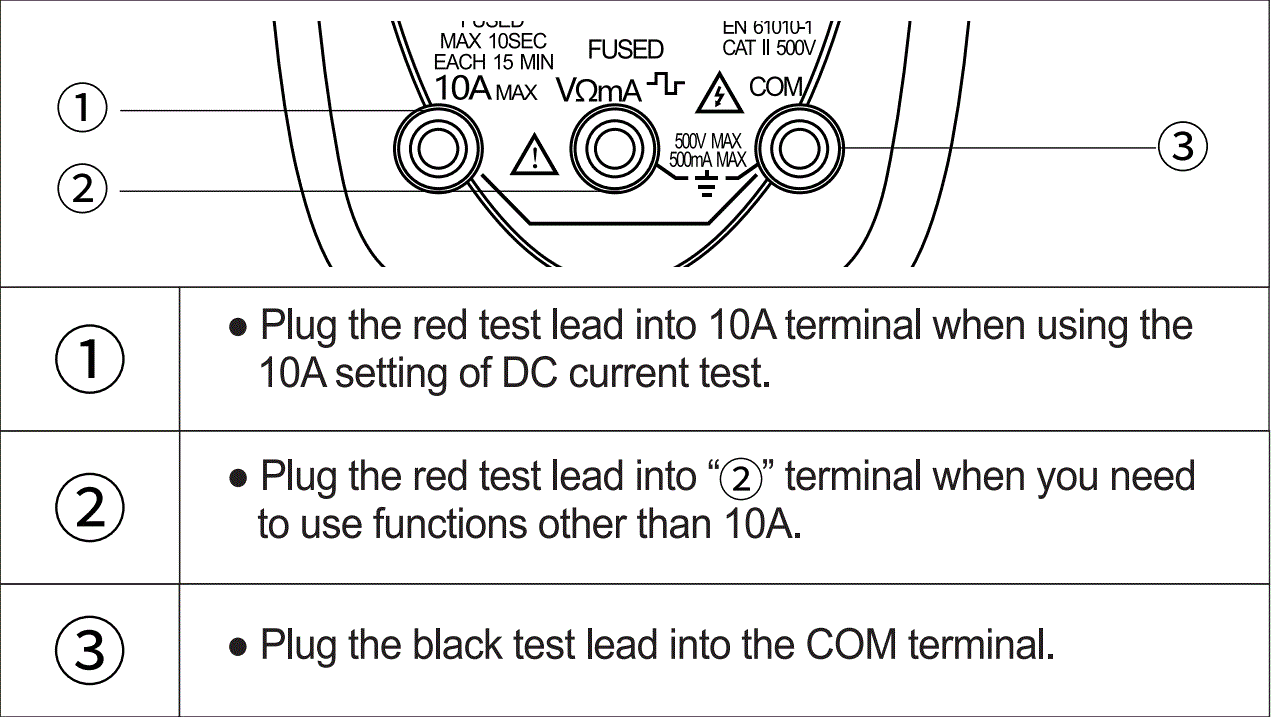
REPLACING THE BATTERY AND FUSE
BATTERY REPLACEMENT:
- Turn off the Meter and remove the test leads.
- Unscrew the screws {that fix the battery cover) with a screwdriver, and remove the battery cover.

- Remove the old battery and replace it with a new battery of the same specification.
- Put the battery cover back to its original position and fix the battery cover with the removed screws.
Battery Type: 1 x 9V Battery NEDA 1604/6F22/006P
REPLACING FUSE:
- Turn off the Meter and remove the test leads.
- Unscrew the screws fixing the battery cover with a screwdriver, and remove the battery cover and the battery.

- Remove the insulating sleeve and screws on the back cover of the Meter.

- Remove the blown fuses and replace them with new fuses of the same specification, make sure that the fuses are loaded into the fuse clip and clamped tightly .

- Put the insulation cover, the battery and the battery cover back, and lock the cover with screws.
THE SPECIFICATIONS OF FUSES:
- Fuse 1: F500mN600V fuse; Size:cp5*20mm
- Fuse 2: F10N600V fuse; Size:cp5*20mm
OPERATION INSTRUCTIONS
- To avoid damage to the Meter, do not measure voltages exceeding 500V.
- This Meter is a manual range Multimeter. Please be sure to choose the correct measuring range to prevent damage.
- Pay special attention to safety when measuring high voltages to avoid electric shock or personal injury.
- Before using the Meter to test a known voltage or current, confirm that the Meter functions work properly.
I .MEASURING AC/DC VOLTAGE:
MEASURING DC VOLTAGE:

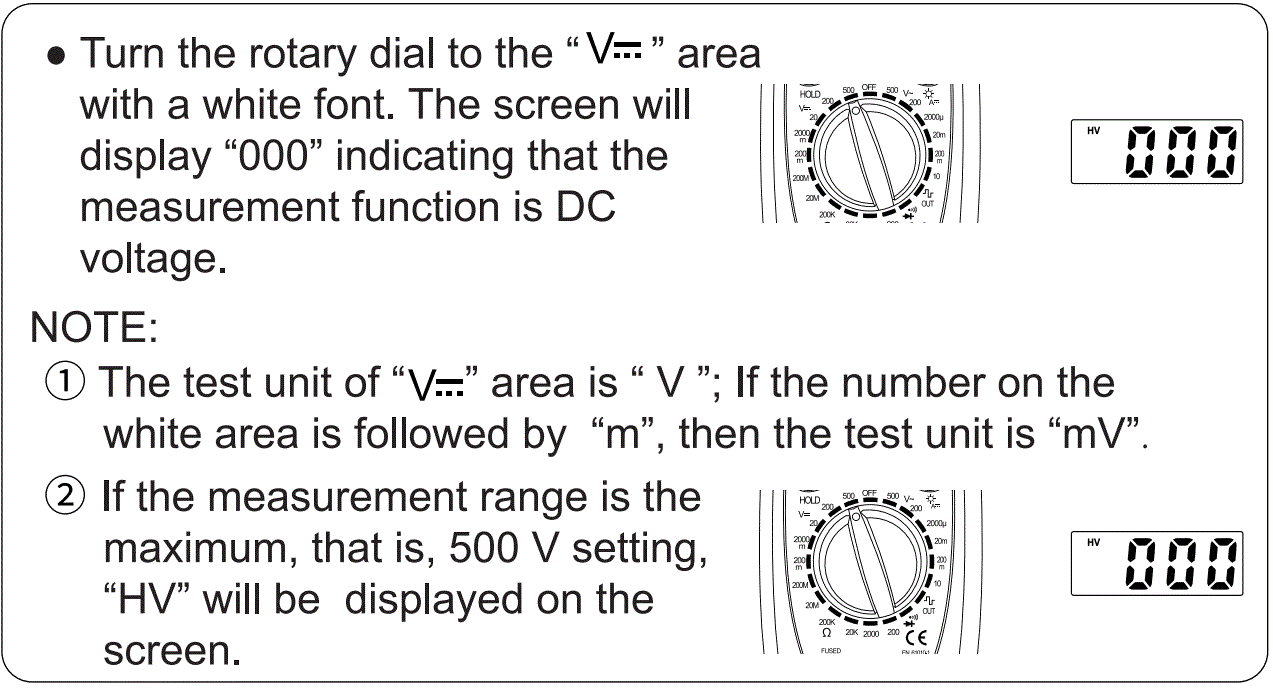
- Connect the test leads to the circuit under test (connect the leads in parallel to the power supply or circuit under test) to measure.
NOTE:
- If the reading is negative when measuring the DC voltage, it means that the positive and negative poles of the test leads are reversed, please change the test leads.
- After the reading stabilizes, record the reading from the LCD screen.
- Turn the rotary switch to the OFF position to turn off the Meter.
MEASURING AC VOLTAGE:


- Connect the test leads to the circuit under test (connect the leads in parallel to the power supply or circuit under test) to measure.
- After the reading stabilizes, record the reading from the LCD screen.
- Turn the rotary switch to the OFF position to turn off the Meter.
VOLTAGE TIPS:
HOW TO FIND A LIVE WIRE IN A SOCKET:
- Switch to the voltage test setting.
- Connect the black test lead to the grounded wire or jack. Connect the red test lead to one of the jacks to be measured.
- Check both jacks. One should have a reading and the other should remain at or near zero. The live wire will have the reading.
VOLTAGE NOTES:
- Choose the 500V setting to measure the unknown voltage first, and then select the appropriate range according to the voltage.
- To avoid damage to the meter, do not measure voltage exceeding 500V DC or 500V AC CATII.
- If the AC setting is used to measure DC and vice versa, an overflow symbol will be displayed. Performing this action has the potential to damage the Meter or any components you are attempting to test.
- When measuring voltage, the result will fluctuate depend ing on the power supply. Generally, the result will fluctuate ±1 0V, which is NOT an inaccurate result.
II.MEASURING DC CURRENT:
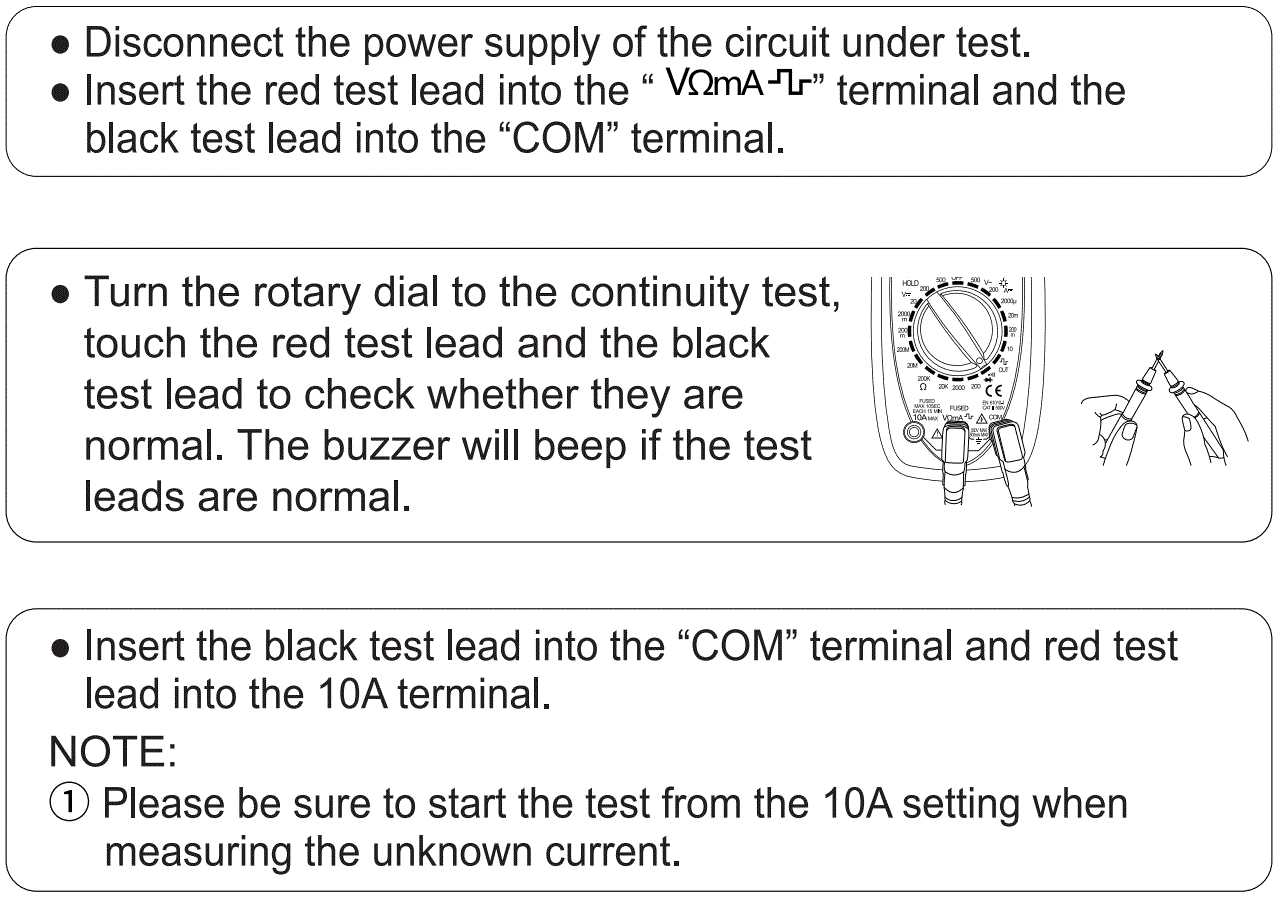

Ill. MEASURING DC A CURRENT:

Choose a larger setting to measure the unknown current first, and then select the appropriate range according to the current.
- Connect the Meter to the circuit under test in series, and then turn on the power supply of the circuit.
- After the reading stabilizes, record the reading from the LCD screen.
- Turn the rotary switch to the OFF position to turn off the Meter.
AUTOMOTIVE PARASITIC BATTERY DRAIN:
- Check if the battery voltage and power generation are within normal range. The battery voltage is generally around 12.7V and the power generation is around 14V.
- Turn off all electrical accessories inside and outside the car and close the doors.
- Remove the negative electrode of the battery. Set the Multimeter to the maximum current level and connect the Meter in series to the battery. Connect the red test lead to the negative line and the black test lead to the battery terminal.
- Adjust the Meter, if necessary, to a lower range.
- Wait for about 30 minutes; after all the modules of the vehicle have entered the sleep state, read the accurate static discharge current. The discharge current is generally 0.02A (20mA), however, this can vary depending on the vehicle. Normally ii will not exceed 50mA.
- If the drain is larger than 50mA, begin checking fuses individually for which circuit is carrying the excess load. If a removed fuse reduces the battery draw to below 50mA, ii can be determined that the corresponding circuit is drawing the excess discharge.
CURRENT NOTES:
- Choose the maximum setting to measure the unknown current first, and then select the appropriate range according to the current.
- If you insert the red test lead into the 1 OA jack, be sure to insert the test lead back into the ” VΩmA” jack after the test to avoid forgetting to switch the jack for the next operation and thus burning the Multimeter.
- When testing a high current, for safety reasons, each measurement time should be less than 10 seconds, and the interval time between tests should be greater than 15 minutes.
- When testing the current, there must be a load in the circuit. Do not connect the multimeter in series with the circuit without a load to measure; doing so can potentially damage the Meter.
- Do not apply a current exceeding the Meter’s range to avoid damaging the Meter.
IV. MEASURING RESISTANCE:

NOTE:
- The test unit of “Ω” area is “Ω”; If the number on the yellow area is followed by a “M”, then the test unit is “MO”; If the number on the yellow area is followed by a “K”, then the test unit is “KO”.
- Choose a larger measurement range to measure the unknown resistance first, then select the appropriate range according to the resistance.
- Connect the test leads to both ends of the circuit or resistor under test (connect the leads to the resistance under test in parallel).
- After the reading stabilizes, record it from the LCD screen.
- Turn the rotary switch to the OFF position to turn off the Meter.
RESISTANCE NOTES:
- Do not change the resistance while taking a measurement. Doing so may damage the Meter and affect the test results.
- Do not test parallel circuits. The accuracy of the measurement will be affected, and the results may not be accurate.
- Do not directly measure the internal resistance of micrometers, galvanometers, batteries, and other instruments.
V .CONTINUITY TEST:


VI.DIODE TEST:

DIODE TEST TIPS:
- Is the diode functioning correctly: If the red test lead is connected to the positive pole of the diode and the black lead is connected to negative, then the diode should be in a forward conduction state, and the displayed value is the forward voltage drop.
- Normal diode forward pressure drop: the general silicon tube is 0.5- 0.7 V, germanium tube is 0.15-0.3V.
- You can also verify that the red test lead is connected to the negative pole of the tested diode and the black test rod is connected to the positive pole. The diode should display”1″.
POLARITY JUDGMENT METHOD:
- Switch the Multimeter to the Resistance setting.
- Connect the two test leads to the two electrodes of the diode.
- Measure one result, then swap the positions of the test leads and measure the second result.
- The larger result is the reverse resistance and the smaller result is the forward resistance. The smaller resistance is when the black test lead is connected to the positive end of the diode and the red lead is connected to the negative end.
VII. SQUARE WAVE OUTPUT:


MAINTENANCE
CLEANING THE METER:
If there is dust or humidity in the terminals, it may produce erroneous measurements. Please clean the Meter as follows:
- Turn off the power to the Meter and remove the test leads.
- Turn the meter over and shake out the dust accumulated in the input jack, wipe the case with a damp cloth or mild detergent. Wipe the contacts in each terminal with a clean cotton swab dampened in alcohol.
SPECIFICATIONS


DETAILED SPECIFICATION
Accuracy is guaranteed for 1 year, with storage conditions of 23°C±5°C, less than 80%RH.
I . DC VOLTAGE

II .AC VOLTAGE

Ill. DC CURRENT

IV. RESISTANCE

V .CONTINUITY TEST

INCLUDED IN BOX
- 1 x User Manual
- 1 x Pair of Test Leads
- 1 x AstroAI Digital Multimeter
1 YEAR LIMITED WARRANTY FROM ASTROAI
Each AstroAI Digital Multimeter will be free from defects in material and workmanship. This warranty does not cover fuses, disposable batteries and damage from neglect, misuse, contamination, alteration, accident, or abnormal conditions of operation or handling, including over-voltage failures caused by use outside the Meter’s specified rating, or normal wear and tear of mechanical components. This warranty covers the original purchaser only and is not transferable.
If this product is defective, please contact AstroAI Customer
Support at [email protected].

Web:www.astroai.com
E-mail: [email protected]
Download PDF
AstroAI Multimeter 2000 Counts Digital Multimeter with DC AC Voltmeter and
Ohm Volt Amp Tester User Manual PDF Download





